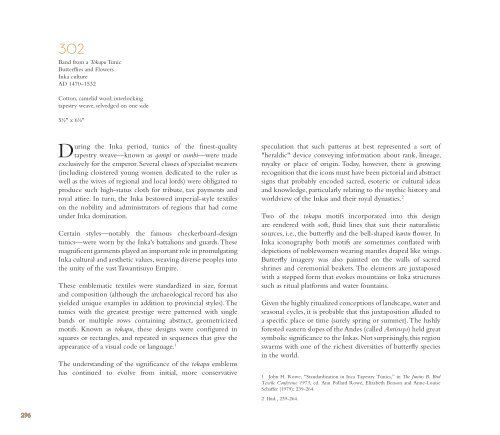Create successful ePaper yourself
Turn your PDF publications into a flip-book with our unique Google optimized e-Paper software.
302<br />
Band from a Tokapu Tunic<br />
Butterflies and Flowers<br />
Inka culture<br />
AD 1470–1532<br />
Cotton, camelid wool; interlocking<br />
tapestry weave, selvedged on one side<br />
5½" x 6½"<br />
During <strong>the</strong> Inka period, tunics of <strong>the</strong> finest-quality<br />
tapestry weave—known as qompi or cumbi—were made<br />
exclusively for <strong>the</strong> emperor. Several classes of specialist weavers<br />
(including cloistered young women dedicated to <strong>the</strong> ruler as<br />
well as <strong>the</strong> wives of regional and local lords) were obligated to<br />
produce such high-status cloth for tribute, tax payments and<br />
royal attire. In turn, <strong>the</strong> Inka bestowed imperial-style textiles<br />
on <strong>the</strong> nobility and administrators of regions that had come<br />
under Inka domination.<br />
Certain styles—notably <strong>the</strong> famous checkerboard-design<br />
tunics—were worn by <strong>the</strong> Inka's battalions and guards. These<br />
magnificent garments played an important role in promulgating<br />
Inka cultural and aes<strong>the</strong>tic values, weaving diverse peoples into<br />
<strong>the</strong> unity of <strong>the</strong> vast Tawantisuyo Empire.<br />
These emblematic textiles were standardized in size, format<br />
and composition (although <strong>the</strong> archaeological record has also<br />
yielded unique examples in addition to provincial styles). The<br />
tunics with <strong>the</strong> greatest prestige were patterned with single<br />
bands or multiple rows containing abstract, geometricized<br />
motifs. Known as tokapu, <strong>the</strong>se designs were configured in<br />
squares or rectangles, and repeated in sequences that give <strong>the</strong><br />
appearance of a visual code or language. 1<br />
The understanding of <strong>the</strong> significance of <strong>the</strong> tokapu emblems<br />
has continued to evolve from initial, more conservative<br />
speculation that such patterns at best represented a sort of<br />
"heraldic" device conveying information about rank, lineage,<br />
royalty or place of origin. Today, however, <strong>the</strong>re is growing<br />
recognition that <strong>the</strong> icons must have been pictorial and abstract<br />
signs that probably encoded sacred, esoteric or cultural ideas<br />
and knowledge, particularly relating to <strong>the</strong> mythic history and<br />
worldview of <strong>the</strong> Inkas and <strong>the</strong>ir royal dynasties. 2<br />
Two of <strong>the</strong> tokapu motifs incorporated into this design<br />
are rendered with soft, fluid lines that suit <strong>the</strong>ir naturalistic<br />
sources, i.e., <strong>the</strong> butterfly and <strong>the</strong> bell-shaped kantu flower. In<br />
Inka iconography both motifs are sometimes conflated with<br />
depictions of noblewomen wearing mantles draped like wings.<br />
Butterfly imagery was also painted on <strong>the</strong> walls of sacred<br />
shrines and ceremonial beakers. The elements are juxtaposed<br />
with a stepped form that evokes mountains or Inka structures<br />
such as ritual platforms and water fountains.<br />
Given <strong>the</strong> highly ritualized conceptions of landscape, water and<br />
seasonal cycles, it is probable that this juxtaposition alluded to<br />
a specific place or time (surely spring or summer). The lushly<br />
forested eastern slopes of <strong>the</strong> <strong>Andes</strong> (called Antisuyo) held great<br />
symbolic significance to <strong>the</strong> Inkas. Not surprisingly, this region<br />
swarms with one of <strong>the</strong> richest diversities of butterfly species<br />
in <strong>the</strong> world.<br />
1 John H. Rowe, “Standardization in Inca Tapestry Tunics,” in The Junius B. Bird<br />
Textile Conference 1973, ed. Ann Pollard Rowe, Elizabeth Benson and Anne-Louise<br />
Schaffer (1979): 239-264.<br />
2 Ibid., 239-264.<br />
296







